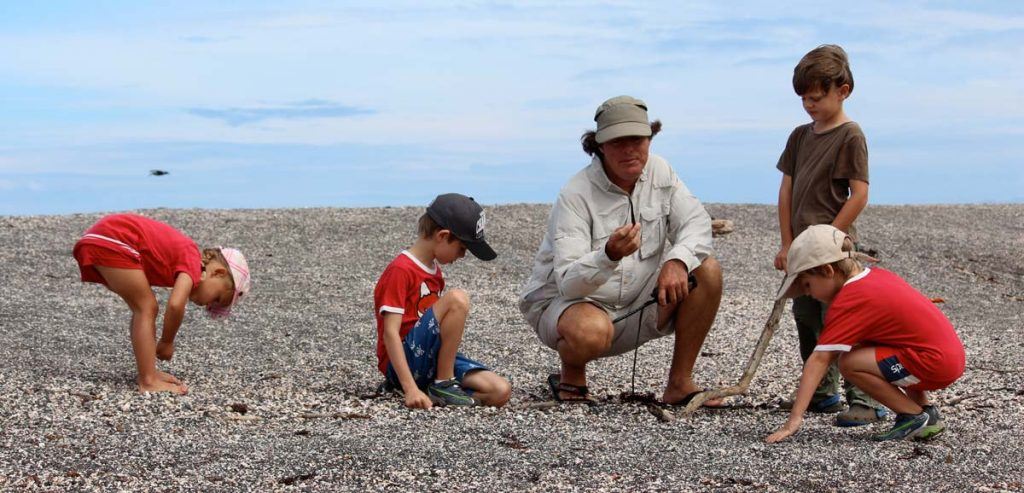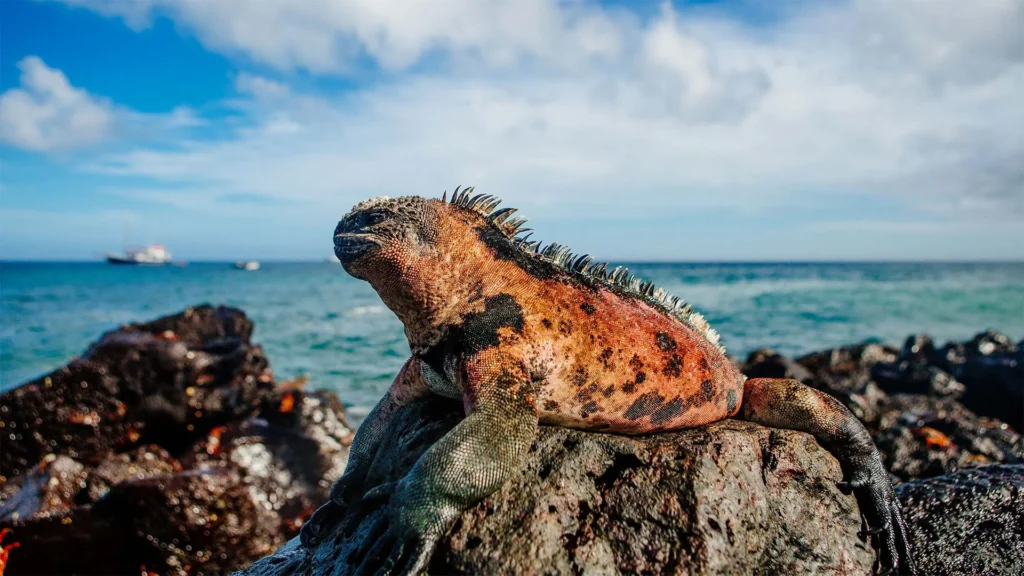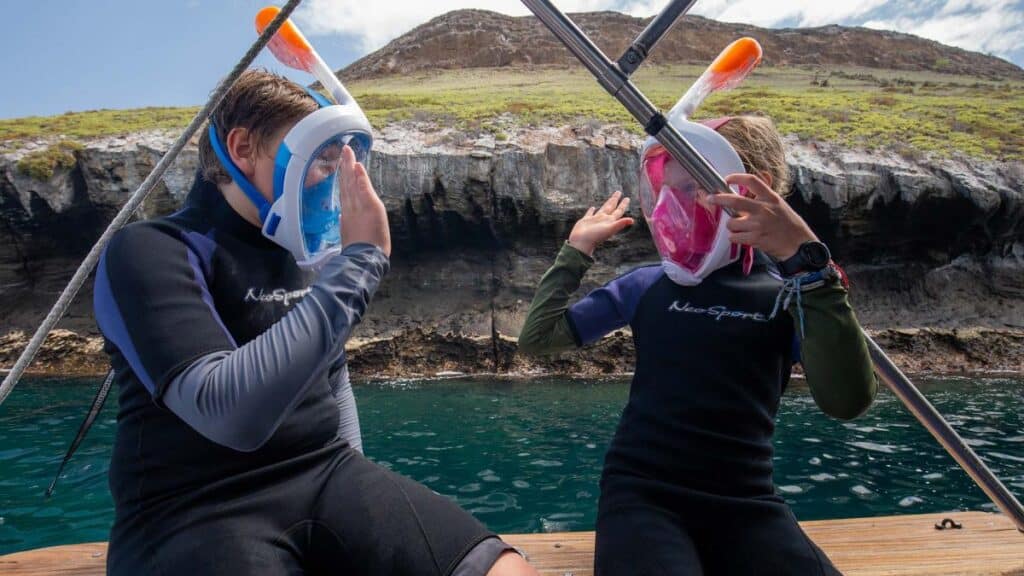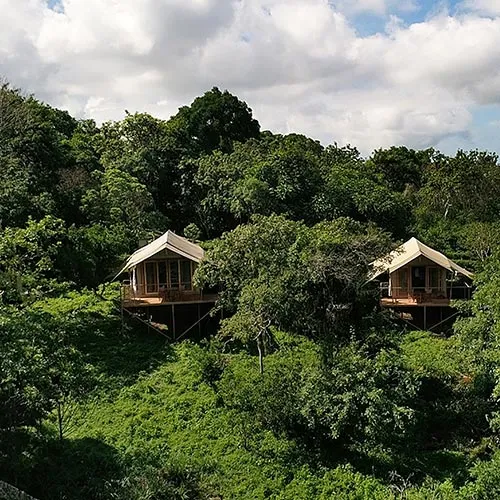
How To Prepare Children for A Galapagos Family Vacation
Visiting the Galapagos Islands with your school or family is, for the majority, an adventure of a lifetime.
From the moment you start planning to the day you set foot on these enchanting islands, each step is a journey towards an enlightening and unforgettable experience.
This guide is packed with invaluable insights to make your Galapagos educational tour both enriching and exciting for every student or family member.
Preparing Your Children for Their Educational Tour in the Galapagos Islands

The Galapagos Islands are a living classroom, brimming with lessons in biology, ecology, geology and conservation.
The drama of the landscapes and the wildlife of the Galapagos is palpable – imagine witnessing the great blackened rock formations, dinosaur-like creatures, and giant tortoises for the first time through the eyes of a child. When they have a little prior knowledge of what they’re likely to see, the appreciation and thrill of encountering it all in person is all the greater.
To maximize this educational adventure, we’ve curated some resources and tips for you to explore as a family. If you have any personal recommendations, we’d love to hear them! Just drop us an email.
Introduce your kids to the Galapagos’ flagship species.
Teach your children how to identify the Galapagos flagship species like blue-footed boobies, sea lions, Scalesia trees and Galapagos penguins. There are also plenty of less common creatures, like the extremely odd-looking ocean sunfish, to learn about; sighting one becomes the precious prize to a daring challenge. Use fun, games and story-telling to pique their imaginations.
Watch Galapagos Documentaries Together.
Sit down with your class or family to watch one of the myriad Galapagos documentaries, like Galapagos with David Attenborough. Look out for Galapagos Safari Camp in the third episode (29 minutes in!).
Little kids may also enjoy some YouTube videos we’ve curated here: Galapagos With Kids Playlist
Listen to Galapagos Podcasts.
What better way to pass a long car or plane journey (and quieten the cries of, “Are we nearly there yet?”) than to listen, as a family, to a Galapagos podcast?
Here are a few we’ve bookmarked.
Galapagos Islands: A little World Within Itself: Sarah Darwin (Charles Darwin’s great, great granddaughter) retraces the journey of her ancestor to explore the evolution and current challenges of the Galapagos, examining the impact of tourism and habitation on the islands’ unique ecosystems and questioning the balance between conservation and development.
Oceans: Life Under Water: A Greenpeace UK podcast that dives into the marvels of the ocean, featuring conversations with experts from freedivers to marine biologists, complemented by immersive sound design to transport listeners to the world’s most mysterious aquatic locations.
These Kids are Hoping to Save Galapagos Tortoises and their Own Homes from Climate Change: Students from Cazares High School in the Galapagos Islands engage in hands-on conservation work with the Galapagos National Park and Ecology Project International, studying the ecology of giant tortoises to prevent their extinction and understanding the impacts of climate change. This educational program immerses students in critical environmental efforts, teaching them to collect data on tortoise populations, amidst challenges like severe droughts affecting the tortoises’ food supply.
The Tale of Darwin and the Beagle (skip the first two minutes!): Áki Jarl Láruson recounts Charles Darwin’s journey as a young naturalist on the Beagle, highlighting Darwin’s early encounters and studies that led to his groundbreaking work, “The Origin of Species.” Láruson, a sea urchin researcher at the University of Hawaii, shares his personal connection to Darwin’s discoveries, emphasizing the enduring impact of Darwin’s theories on evolutionary biology, evidenced by his own formative experience with sea urchins and Darwin’s insights into their distribution influenced by geographical barriers.
How Charles Darwin Worked (skip the first two minutes!): A comprehensive discussion on Charles Darwin’s contributions to the theory of evolution, including the origins and impact of his work, the concept of natural selection, and the reactions it provoked. It also explores Darwin’s personal journey, the influence of his discoveries on various fields, and the lasting legacy of his ideas in shaping scientific and societal views on evolution and natural selection. Produced by Stuff You Should Know.
How Natural Selection Works. An in-depth exploration of natural selection, discussing its mechanisms, examples in nature, and its impact on evolution. It delves into the role of genetic variation, the struggle for survival, and the influence of environmental pressures on the propagation of advantageous traits. Additionally, it addresses misconceptions, the interplay between genes and evolution, and the phenomenon of vestigial traits, offering insights into how natural selection shapes the diversity of life on Earth.
Enriching Your Family’s Journey: Educational Content
Galapagos Books for Kids
A variety of books tailored to different age groups can deepen your children’s understanding and anticipation for the trip. From storybooks to science guides, these resources make learning about the Galapagos fun and engaging.
Note the age guides are approximate.
Galapagos books for age 2+
A Blue-footed Booby Named Solly McBoo
Tomas and the Galapagos Adventure
Grandmother Fish: A Child’s First Book of Evolution
Galapagos books for age 5+
The Adventures of Piratess Tilly
Island: A Story of the Galapagos
We’re sailing to the Galapagos
Life on Earth: The Story of Evolution
Galapagos books for age 8+
Where are the Galapagos Islands?
An Old Shell: Poems of the Galapagos
Charles Darwin and the Beagle Adventure
Charles Darwin (Giants of Science)
The True Adventures of Charley Darwin
Galapagos books for young adults
Monkey Town: The Summer of the Scopes Trial
Charles and Emma: The Darwins’ Leap of Faith
Manage expectations but feed the excitement

Make sure that your trip is 100% wonder and 0% disappointment by explaining to your children what to expect from the vacation, both the good and the bad. Ease in with the boring parts.
Galapagos safaris are all about nature and wildlife. There’s not much else in terms of entertainment; Wi-Fi and electric devices are often pretty redundant across the entire archipelago. Boat rides can be up to 2 hours, where you walk is restricted by park rangers, and you’re not allowed to touch the animals.
With the reality check out of the way, it’s time for the magic! Your children will never be closer to wild animals, they’ll be sleeping in a luxury safari tent in the wild, strolling with giant tortoises, discovering active volcanoes, swimming with penguins, and learning how the world – and everything in it – came to be how it is. Netflix can take a hike.
Learn to swim and to snorkel

The islands are incredible, and the waters around them reveal another world of marvels. Although you will always be accompanied by an experienced guide, and there’s never any obligation to take a dip, it is important that everyone in your family feels comfortable out at sea.
If a child can practice using a mask and snorkel (even if it’s in the bathtub!) it will give them the confidence needed to jump into the water, and into one of the world’s most exciting marine reserves.
Language and Cultural Immersion
Study Spanish Together.
While most guides and people working in the Galapagos will speak English (including the team at Galapagos Safari Camp), learning basic Spanish phrases can enrich your family’s interaction with local communities and enhance the educational value of your tour.
Numbers, ‘please’, ‘thank you’ and introductions are a great place to start, but you could also get clued up on some of the animals you’re likely to spot, and the experiences you’re likely to have. For example:
Playa – beach
Lancha – boat
Isla – island
Lobo del mar – sea lion
Pingüino – penguin
Tortuga – turtle
Piquero de pata azules – blue-footed booby
Tiburón – shark
Ballena – whale
“Spanish Mama” has put together some great learning resources for learning Spanish here.
Engage with Educational Activities at Galapagos Safari Camp
The learning doesn’t stop once you reach the Galapagos. Participate in the educational activities offered by Galapagos Safari Camp including:
Family-friendly guided expeditions that encourage questions and discoveries about the local ecosystem.
Carefully selected, family-friendly guides know how to connect with children and encourage them to ask questions during expeditions (come with your own prepared list!).
And once back at our Family-Friendly Camp, quotes and quizzes over breakfast and dinner, and creative kids’ club activities like making blue-footed boobies and marine iguanas with a wine cork, are a fun way for children to reflect upon new knowledge and deepen their connection to the islands.
Plan Your Galapagos Island Educational Adventure!
Ready to embark on an unforgettable educational tour of the Galapagos Islands with your family? Our family-friendly itineraries are designed to provide an immersive, educational experience that will leave you with a deeper understanding and appreciation of this unique ecosystem.
Explore our Family Safari options and start planning your educational adventure today!
Summary
Embarking on a Galapagos educational tour is not just about seeing new places; it’s about inspiring a sense of wonder and responsibility towards our planet in the hearts of young learners. By following this guide, you’re not just planning a vacation; you’re investing in an educational adventure that will enrich your children’s lives and memories forever.
You Might Also Be Interested In
See below further resources for educational and family-related travel in the Galapagos Islands.
Recommended Galapagos Books (for the grown-ups)
Can you be too young for the Galapagos Islands?
A Grand Galapagos Safari – A Multigenerational Galapagos Adventure
